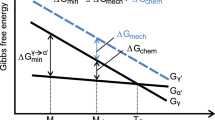Abstract
The hardness and fatigue strength achieved by strain hardening are normally noticeable lower than those attained by thermal or thermochemical heat treatments. Strain or deformation induced martensitic transformation of residual austenite can increase the strength achieved by mechanical surface hardening processes considerably. In this paper, an approach is presented where workpieces with a high content of metastable austenite are used for hardening the surface layer. The microstructure has to be sufficiently stable, in order to ensure that the material can be machined without being changed by strain induced transformation of the residual austenite. After machining, high Hertzian contact stresses are introduced by deep rolling, so that a strain induced martensitic transformation of the residual austenite takes place. At the same time deep rolling produces the surface finish of the part. By this method, a surface hardening without a heat treatment process within the production line can be realized. A conceivable use of this method could be the production of bearings or guideways.











Similar content being viewed by others
References
El-Axir MH (2000) An investigation into deep rolling. Int J Mach Tools Manuf 40:1603–1617
Hirsch T, Wohfahrt H, Macherauch E (1987) Fatigue strength of case hardened and shot peened gears. In: Wohlfahrt H, Kopp R, Vöhringer O (eds) Shot peening: science, technology, application. DGM Informationsgesellschaft, Oberursel pp 547–560
Schuhbauer H-G, Bäuerle H, Müller-Stock H-W (1991) Schwingfestigkeitssteigerung schwerer Maschinenbauteile durch Schlagverfestigen. Konferenz-Einzelbericht: Moderne Fertigungs-technologien zur Lebensdauersteigerung, 17. Vortragsveranstaltung des DVM-Arbeitskreises Betriebsfestigkeit, pp 53–64
Röttger K (2003) Walzen hartgedrehter Oberflächen. Dissertation Dr.-Ing. RWTH Aachen. Shaker Verlag, Aachen
Brinksmeier E, Roth P (1990) Hochdruck-Wasserstrahlen—ein neues Verfahren zur mechanischen Randzonenverfestigung. HTM 45:300–306
Tönshoff H-K, Kroos F, Marzenell C (1997) Improving fatigue strength of finished case hardened components by high-pressure water peening. Prod Engineer 4:67–72
Papshev DD (1985) Effektive Methoden der mechanischen Oberflächenverfestigung.Mitteilungen aus dem Institut für Leichtbau und Ökonomische Verwendung von Werkstoffen. Dresden 24:40–43
Schwarmann L (1994) Methoden zur Steigerung der Lebensdauer genieteter Fügungen im Flugzeugbau (Speziell das Aufdornverfahren). Konferenz-Einzelbericht: Fügen im Leichtbau, 20. Vortragsveranstaltung des DVM-Arbeitskreises Betriebsfestigkeit, pp 227–232
Plappert S (2001) Zur Steigerung der Dauerfestigkeit dickwandiger, quergebohrter Rohre durch autofrettage. Dissertation, University of Erlangen-Nürnberg
Greuling S, Seeger T, Vormwald M (2006) Autofrettage innendruckbelasteter Bauteile. Materialwissenschaft und Werkstofftechnik 37:233–239
Reissner J (1999) Innovation potential of materials and their impacts on processing in forming technology. Advanced technology of plasticity, vol 1. Proc of the 6th ICTP, Sept 19–24, pp 409–418
Wei X, Xie Q, Zhang M, Li L, Wollants P (2007) Influence of strain-induced retained austenite transformation on the dynamic tensile behaviour of TRIP-aided steels. Steel Res Int 78:554–559
Razim C (1968) Über den Einfluß von Restaustenit auf das Festigkeitsverhalten einsatzgehärteter Probekörper bei schwingender Beanspruchung. HTM 23:1–8
Kloos K-H, Kaiser B, Adelmann J (1989) Einfluß einer mechanischen Randschichtverfestigung auf die Ermüdungseigenschaften einsatzgehärteter Proben und Zahnräder. In: Broszeit E, Steindorf H (eds) Mechanische Oberflächenbehandlung—Festwalzen, Kugelstrahlen, Sonder-verfahren. DGM Informationsgesellschaft, Oberursel
Tamura I (1982) Deformation-induced martensitic transformation and transformation-induced plasticity in steels. Mater Sci 16:245–253
Weiß A, Gutte H, Scheller P (2006) Deformation induced martensite formation and ist effect on transformation induced plasticity (TRIP). Steel Res Int 77:727–732
Onodera H, Goto H, Tamura I (1976) Effect of volume change on martensitic transformation induced by tensile or compressive stress in polycristalline iron alloys. Proc. 1st JIM Int Symp, Kobe, Japan, pp 327–332
Bayerlein M, Christ H-J, Mughrabi H (1989) Plasticity-induced martensitic transformation during cyclic deformation of AISI 304L stainless steel. Mater Sci Engineer A114:L11–L16
Oettel H, Martin U (2006) The nature of the TRIP-effect in metastable austenitic steels. Int J Mater Res 97:1642–1647
Ganesh SR, Padmanabhan KA (1994) Influence of martensite formation and grain size on room temperature low cycle fatigue behaviour of AISI 304LN austenitic stainless steel. Mater Sci Technol 10:614–620
Garbrecht M (2006) Mechanisches Randschichthärten in der Fertigung. Dissertation Dr.-Ing. Universität Bremen, Shaker-Verlag, Aachen, ISBN 3–8322–5262–2
Lecroisey F, Pineau A (1972) Martensitic transformations induced by plastic deformation in the Fe-Ni-Cr-C system. Metall Trans 3:387–396
Murr LE, Staudhammer KP, Hecker SS (1972) Effects of strain state and strain rate on deformation-induced transformation in 304 stainless steel: Part II. Microstructural study. Metall Trans 13A:627-663
Acknowledgments
The authors thank for the projects funding by Bundesministerium für Wirtschaft und Technologie (BMWi) via Arbeitsgemeinschaft industrieller Forschungsvereinigungen (AiF) and the assistance of the working commitees “Fertigungstechnik” and “Werkstoffe” of Forschungsvereinigung Antriebstechnik e.V. (FVA) and Arbeitsgemeinschaft Wärmebehandlung und Werkstofftechnik e.V. (AWT).
Author information
Authors and Affiliations
Corresponding author
Rights and permissions
About this article
Cite this article
Brinksmeier, E., Garbrecht, M., Meyer, D. et al. Surface hardening by strain induced martensitic transformation. Prod. Eng. Res. Devel. 2, 109–116 (2008). https://doi.org/10.1007/s11740-007-0060-6
Received:
Accepted:
Published:
Issue Date:
DOI: https://doi.org/10.1007/s11740-007-0060-6



